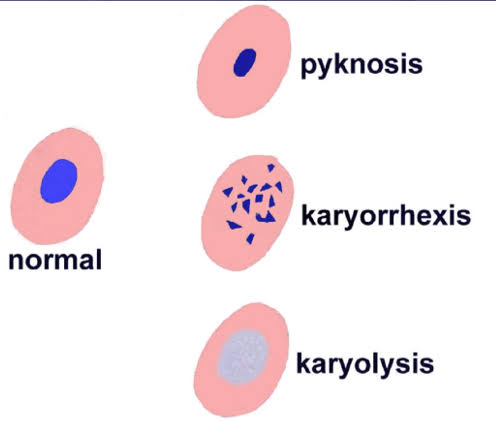Cell injury as the word simply suggests means any injury to the cell.
Cell injury is mainly of two types –
Reversible cellular injury
Irreversible cellular injury
Reversible cellular injury
- Main cause of reversible cellular injury – Hypoxia (decreased O2)
- First change of cellular injury – Mitochondrial dysfunction
- This mitochondrial dysfunction leads to ATP depletion. This ATP depletion leads to the following –
Failure of sodium potassium ATPase pump.
Anaerobic glycolysis
Decreased potassium synthesis.
Failure of sodium ATPase pump
- In normal condition sodium potassium potassium ATPase pump pumps 3 Na+ outside the cell and 2 K+ inside the cell but during the failure of the pump this process is reversed, 2 K+ goes outside the cell and 3 Na+ reaches inside the cell, this leads to influx of water which further leads to Hydropic changes or say cellular swelling.
- First morphological change of cellular injury – Cellular swelling
- Other changes due to the failure of pump are –
Cell swelling
ER swelling
Flattening of microvilli
Formation of cytoplasmic blebs (due to influx of water)
Formation of myelin figures - Myelin figures – These are concentric lamellations derived from cell membrane. As cell membranes are mainly composed of phospholipids, main content of myelin figures are phospholipids but they also contain Ca2+.
Myelin figures can be seen in both reversible and irreversible cell injury but they are more in case of irreversible cell injury.
Anaerobic glycolysis –
Anaerobic glycolysis leads to decrease in pH due to accumulation of lactic acid. This further leads to Nuclear chromatin clumping.
Decrease in protein synthesis –
During reversible cell injury, ribosomes detach from rough endoplasmic reticulum (RER), this leads to decrease in protein synthesis which leads to increased fat which ultimately results in fatty changes in the cell.
Two defining moments of conversion of reversible cellular injury to irreversible cellular injury –
- Severe membrane damage.
- Severe mitochondrial damage.
Irreversible cell injury
Irreversible cellular injury leads to membrane damage which causes Ca2+ influx. This calcium leads to –
Formation of amorphous flocculent densities –
Deposition of calcium on mitochondria leads to formation of amorphous flocculent densities.
Main composition of amorphous flocculent densities is Ca2+
Activation of enzymes –
Calcium influx activates several enzymes which are –
Phospholipase
Protease
Nuclease
Nuclear changes in irreversible cellular injury –
Pyknosis – This is the stage of nuclear chromatin condensation (Nuclear shrinkage)
Karyorrhexis – This is the stage of nuclear fragmentation.
Karyolysis – This is the stage of nuclear dissolution.
